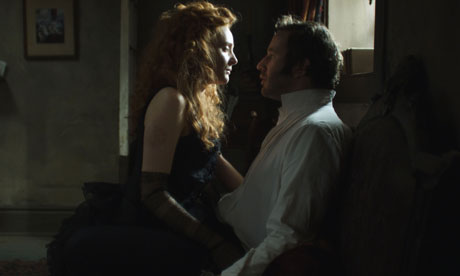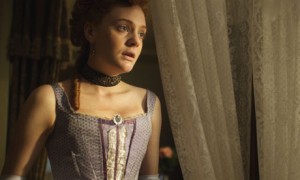You have no items in your cart. Want to get some nice things?
Go shopping
The BBC’s adaptation of Michel Faber’s novel, The Crimson Petal and the White, recently came to its open-ended conclusion, and consequently spurred on passionate discussions on internet forums and the like about whether or not the ending should have wrapped up its myriad of loose ends. The Guardian’s episode by episode guide was teeming with comments about its unresolved ending: one commenter admitted that she was unsure of her feelings of its evasive ending as she’d hoped for complete ‘reassurance that the girls lived happily ever after”; however, another reader argued that the ending was indeed satisfying, ‘To conclude everything neatly and happily (for Sugar, Sophie and Agnes) would have seemed unrealistic and forced’.

The Crimson Petal and the White tells the story of an intelligent and cunning Victorian prostitute’s determined ambition to rise above her circumstances. When her life becomes entangled with the perfume magnate, William Rackham, she does all she can to reach the top. Yet, by the final episode, self-absorbed William cruelly casts Sugar out into the streets. The BBC concluded its four part series with the red-haired protagonist staring into a miasma of murky, unfurling smoke, which suitably matched the equally murky, cloudy and unclear ending. The audience is left with an overwhelming bundle of unanswered questions. How does Sugar spend the remainder of her days – despondent or with renewed vigour? Where is her next destination? How will she survive? And these are just the questions concerning this particular character; there are also numerous points to be asked about a whole host of other characters: William and his daughter, Sophie, his wife, Agnes, Sugar’s mother, Mrs Castaway… However, despite all of these untied threads I find myself rather in favour of its surprising and mysterious ending. The lack of solid solutions in the finale increased the unnerving and shocking impact of the story. The Guardian commenter, earlier mentioned, yearned for a soppy, ‘happily ever after’, fairytale, but this isn’t a saccharine, sunshine style story. This is an intensely dark, harsh and gritty tale that needed to end with a similarly unsettling avalanche of emotions. If the hauntingly gloomy production had ended tidily there wouldn’t have been the incredibly subtle and superb symbolism of Sugar opening up a brand new book, her pen poised over a blank page in eager anticipation of a writing a new narrative, and thus beginning a new chapter of her life.
This has led me to think of other tales that have also resisted the idea of an ending with every query explained and every problem eradicated. Henry James’ intriguing novella, The Turn of the Screw, is one such notable (and may I add successful) example of a story ending with an enigmatic eeriness. A young, governess becomes increasingly obsessed and petrified that malicious, ghostly spirits are intent on stealing the innocence of her young charges away. This piece of fiction again ends with uncertainty; this time about whether the governess’ wild spectral theories are indeed valid or whether these are the governess’ insane imaginings. Thus, the most crucial and interesting aspect of the novel is analyzing the psychology of the governess’ emotional turmoil and mental chaos. By creating an ambiguous ending James shows us how complex, deep and intricate are psychological states of minds really are. What is more, James’ bizarre masterpiece capsizes notions of the traditional realist narrative’s preference for orderliness, and the detective novel’s format of perplexingly weird activity being solved in its final pages. Instead of deciphering the mystery, James creates yet further mysteries in his own novella’s closure. Surely if someone decides to challenge conventional ideas of a story’s structure, to do something different and more unusual, the artist deserves to be applauded? Another example is Herman Melville’s lesser known work, Pierre or The Ambiguities, which I assert is the work of a colossal genius. The central character of the plot, Pierre Glendinning, meets a captivating lady, Isabel Banford, who claims to be his half-sister. They embark on an utterly destructive and incestuous relationship, which is absolutely gripping to read. Isabel’s character remains a hugely bewildering puzzle right up to the last page. Is she an excessively domineering, scheming embodiment of evil controlling Pierre with an assortment of tricks and sorcery or is she genuinely his innocent, tremulous sister who needs comforting protection? Melville has adventurously decided to avoid a direct, straightforward and simple story, and makes his work a sequence of riddles, encouraging readers to become active participants of the narrative. Melville invites readers to a stimulating, thought-provoking challenge, as each meandering sentence is yet another point to rigorously ponder and speculate over.
Don’t get me wrong I don’t necessarily think that it is absolutely imperative that all stories should contain a swarm of question marks hovering over the final moments of every narrative. But I do insist that sometimes inconclusive endings can be regarded as wise and carefully thought out artistic decisions.

About Emily Cleaver
Emily Cleaver is Litro's Online Editor. She is passionate about short stories and writes, reads and reviews them. Her own stories have been published in the London Lies anthology from Arachne Press, Paraxis, .Cent, The Mechanics’ Institute Review, One Eye Grey, and Smoke magazines, performed to audiences at Liars League, Stand Up Tragedy, WritLOUD, Tales of the Decongested and Spark London and broadcasted on Resonance FM and Pagan Radio. As a former manager of one of London’s oldest second-hand bookshops, she also blogs about old and obscure books. You can read her tiny true dramas about working in a secondhand bookshop at smallplays.com and see more of her writing at emilycleaver.net.




